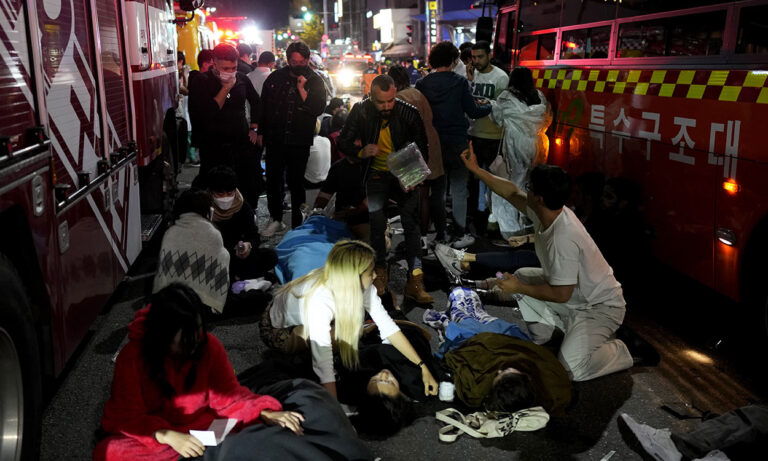Seoul Halloween tragedy: Here is some advice that could save your life in a crowd crush
On 29 October 2022, a reported 153 people were killed during a fatal crowd crush in Itaewon, a district in Seoul, South Korea. Tens of thousands of young people had flocked to the popular nightlife area in order to celebrate Halloween mask-free after three gruelling years of COVID-19 pandemic restrictions. Now, only a few days after the tragedy, many are reflecting on the deadly nature of crowd crushes—and considering the most effective ways to survive if confronted with a dangerous crowd.
What happened in Itaewon?
According to The Guardian, the crush occurred at approximately 10.20pm after crowds surged into a steep and narrow alleyway. Almost instantly, many began to push from the back, others lost their footing, and consequently, a domino effect led to dozens of individuals dying from compressional asphyxia—a condition that occurs when respiration is restricted due to external pressure on the body.
South Korea’s leader, President Yoon Suk-yeol, has pledged that authorities will conduct a thorough investigation into the cause of the incident and will subsequently implement necessary changes which should prevent a disaster such as this from happening again.
Not an isolated incident
Unfortunately, these kinds of public tragedies have become far too recognisable. In 2021, ten people died—eight on the night and two later in hospital—from a crowd crush during Travis Scott’s Astroworld Festival. In this particular occasion, Scott was heavily criticised for refusing to act sooner after it was made clear that members of the audience were being compressed and trampled—a dark night which forced many performers to reevaluate the need for greater crowd control and security.
On 1 October 2022, another fatal crowd disaster occurred in an Indonesian football stadium, claiming 125 lives. In this instance, a pitch invasion turned overtly sinister after riot police officers fired tear gas at the crowd—ultimately resulting in a devastating stampede.
Following the tragedy in Seoul, The Washington Post spoke with G. Keith Still, crowd safety expert and visiting professor of crowd science at the University of Suffolk in the UK. Still explained that “crowd surges can be triggered by many tight situations, for example, when people push others or if someone trips. But the events are not usually caused by people in distress or pushing to get out of a crowd. Those reactions typically come after the crowd starts collapsing.”
He continued: “People don’t die because they panicked. They panic because they’re dying. So what happens is, as bodies fall over, as people fall on top of each other, people struggle to get up and you end up with arms and legs getting twisted together.”
Some individuals have also utilised TikTok as a way in which to provide crucial information surrounding these events—and one video in particular stands out as a source of information everyone should listen to.
Creator @sietethe7 posted a video on 31 October, a few days after the Seoul disaster, detailing some of the most important factors to consider when confronted with a crowd crush:
@sietesays Knowledge saves lives #itaewon
♬ original sound - Siete(𝟕𝟕𝟕)🛸🫧
What’s the difference between a stampede and a crowd crush?
One of the most notable aspects of Siete’s video is the way in which they describe the difference between a stampede and a crowd crush. News outlets have historically used these terms interchangeably, thereby potentially confusing readers and spreading misinformation in regards to prevention methods.
Siete explained: “To call a crowd crush a stampede is not entirely accurate because, in a stampede, people are able to run or move but in a true crowd crush you are unable to do either of those things.”
“This is because highly-dense crowds become fluid in nature. Think of the feelings you get when you are in the ocean and the waves are pushing you around—when this happens, people completely lose control of their bodies and are forced to go in whatever direction the crowd is forcing them into,” the creator continued.
How to identify if the crowd you are in is becoming dangerous
Further along in the video, Siete also identified two ‘types’ of crushes that may result in fatalities—a crowd surge and a crowd collapse. A surge refers to when those at the back of a crowd push forward, while a collapse depicts what may happen if an individual at the front of a crowd falls, creating a domino effect.
Siete stated: “If you are in a packed crowd and find yourself unable to control the direction that you are moving in, you are already in danger. If you are able to, try your absolute best to turn around and go back. A huge red flag is if you are touching people on two or more sides of your body. If you are touching people on all four sides of your body, you are already in danger.”
“Another red flag is if a crowd is pressing into a wall, a barricade, or a gate—this can become extremely dangerous,” they continued.
Things to remember if you find yourself in a crowd crush
While crowd crushes can often be highly difficult to escape, Siete also provided their followers with some potentially life-saving advice.
“If you are at the very back of an extremely dense crowd, do not press forward as this can cause harm to people at the front. If the people in front of you are telling you to turn around and go back and you are able to, please turn and leave immediately.”
If you’re unable to leave, try your hardest to move with the crowd rather than fighting it. This should also allow you to preserve as much energy and oxygen as possible. Keep your arms tucked into your chest and avoid falling to the ground. However, if you do fall, try and maintain a foetal position with all of your limbs tucked inwards.
The New York Times recently interviewed a team of crowd control experts who echoed Siete’s advice, placing emphasis on trying to fight the urge to resist the movement of the crowd and instead prioritising conserving energy.
In terms of crowd control methods and crush prevention, there is still much room for improvement. Despite the launch of the Global Crowd Management Alliance (GCMA) in 2021, responsible crowd management is heavily lacking.
Both the unpredictability of crowds and absence of basic crowd safety training has led to a series of devastating incidents over the past few years. However, providing the general public with awareness of what to do if confronted with a crowd crush is undoubtedly a welcome development.






